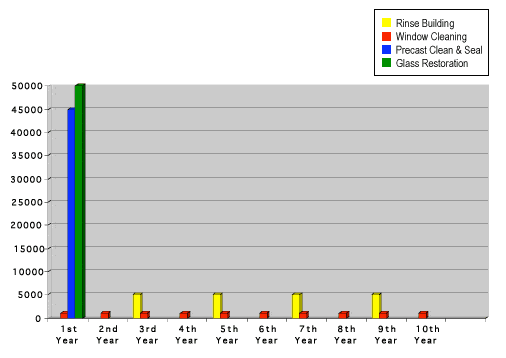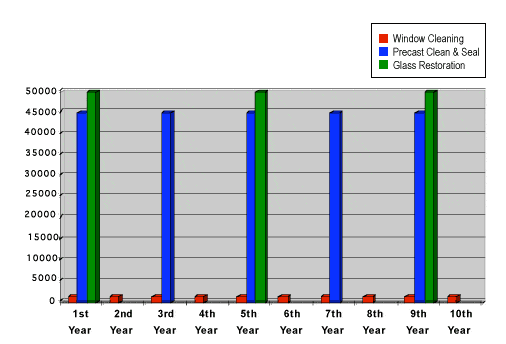Presto’s Green Synergy Products™ will save you money versus using outdated industry standard product options and techniques to restore and maintain your building. Our protective products are designed using the purest high performance silicone materials available. Our exterior cleaning products work harmoniously with these materials in order to protect and maintain architectural materials in an unprecedented manner. You will never have to restore your glass again.
USING PRESTO’S GREEN SYNERGY PRODUCTS™
THE 10 YEAR COST FOR RESTORATION AND MAINTENANCE SERVICES: $132,000

USING INDUSTRY STANDARD PRODUCT OPTIONS
THE 10 YEAR COST FOR RESTORATION AND MAINTENANCE SERVICES: $387,500

Statistics include exterior maintenance services performed on a building consisting of precast, glass and anodized aluminum frames. This building is seven stories high and consists of approximately 145,000 square feet of Class A office space.
We have seen countless buildings which have undergone the costly process of glass restoration, precast cleaning, and the application of sealant, only to have the stains redevelop in higher concentrations within 2 to 3 years.
Both examples show an initial restoration of the property, which consisted of cleaning the precast and removing mineral deposits from the glass. In addition, industry standard periodic maintenance of the building’s exterior, including window cleaning and pressure washing, are also depicted in both examples.
The “industry standard” model contains several services that are required more frequently than the model depicting the use of Green Synergy Products™. This increased frequency is due to the discoloration of building materials. For example, when the precast developed black biological and environmental staining, the precast was cleaned and sealed. In the same manner, when the windows became stained, the windows were restored.
If you are familiar with property maintenance, you should recognize all of the services in both examples except for “Rinse Building”. This is a service which is not normally performed for commercial properties. When our sealers are used in combination with our cleaning products, this procedure will help to reduce the amount of biological and environmental staining which is allowed to soil the structure. This process will inexpensively and effectively wash down the loose soils that have accumulated on the exterior of the building, eliminating the need for close contact pressure washing and the reapplication of sealer. Deionized water can be used without harming our protective coatings. Many times a full pressure washing is performed when only a rinse down is needed. In reality, a building needs to be cleaned on an annual or bi-annual schedule in the same manner as a residential structure.
Presto’s GREEN SYNERGY PRODUCTS™ used to maintain the property in graph #1:
- Stone Restore® Series – To properly clean the precast material.
- Leach Stop® – To apply invisible protection to the precast material.
- Glass ReSurfacer® Series – To restore the surface of glass.
- Glass Defender® Series – To apply invisible protection to the glass surfaces.
Industry standard practices for maintaining exterior building surfaces in chart #2:
- Dawn® or Joy® dish soap to clean the windows using tap water.
- 40% silane or siloxane based water repellants used to seal the precast.
- Pressure washing with tap water to clean the stone.
- Mild abrasive or acid formula to restore the windows.
Summary: Presto’s Green Synergy Products™ and service recommendations will help retain cleanliness all year round, and you will never have to restore your architectural glass surfaces again. Property owners or managers often think that: By focusing on the bottom line, they are able to save money on maintenance in the long run. In actuality, industry standard services and products actually cost the property up to 2 times more in maintenance. In addition to these outrageous costs, the property will often appear dirty and stained all year long, and after a 10 year period of inferior maintenance, approximately 1000 gallons of petroleum based products and hundreds of gallons of harsh cleaning materials were released into our environment due to the use of outdated products.
Another side effect of the constant restoration, which is called for when industry standard products and techniques are utilized, is that the exterior glass becomes severely scratched. This scratching is very costly to remove, and can often be permanent. The additional cost, associated with removing scratches caused by improper restoration techniques, is not factored into this model.
These may not be the actual prices associated with the services which occurred for this property. These prices are estimated based on the cost of services that are normally performed, using products that are typically used. The dollar amounts used for the individual services are calculated at today’s industry standard pricing.
Where do these stains come from?
These stains are caused by improper maintenance of a property and the use of inferior products during that maintenance. Below is a list of commonly performed services at commercial properties, the negative effect the service has on the building, and Presto’s solution to the problem.
Window Cleaning
- Industry Standard Service: Tap water & oily surfactant based detergent; normally either Joy® or Dawn®
- Problem: Tap water deposits high amounts of minerals onto the surface of the building, these minerals help to cause glass stains. Sticky oily dish soap attracts and glues contamination onto the the building, which the sun bakes onto the architectural surfaces including the glass.
- Presto Solution: Clean only with deionized water 2-3 times annually.
Pressure Cleaning Precast
- Industry Standard: Cold tap water high pressure washing
- Problem: Tap water deposits high amounts of minerals onto the surface of the building, minerals that help to cause the glass stains.
- Presto: Presto’s Stone Restore® Series thoroughly cleans stone surfaces, often without the need of high pressure, in preparation for water repellant. In addition we use a special filtration system to remove all minerals from the tap water. The water is also heated for greater cleaning action.
Application of Sealer to Precast
- Industry Standard: Silane or siloxane based water repellants
- Problem: Silane & siloxane start to break down immediately when exposed to UV light from the sun. These molecules fall out of the stone surface and end up on the glass, aiding in the development of glass stains.
- Presto: Presto’s Leach Stop® utilizes silicone technology that lasts 10 to 20 years without breaking down causing stains on the glass.
Glass Restoration & Preservation
- Industry Standard: Mild abrasives or harsh acidic products used to remove the glass stains
- Problem: These products damage the surface of the glass causing scratches or burns. The stains begin to redevelop within months after restoration.
- Presto: Presto’s Glass ReSurfacer® Series safely and effectively restores architectural glass surfaces producing the most superior results in the industry. Presto’s Glass Defender® Series is composed of a full line of products which protect the glass after restoration for 5, 10, or even up to 20 years, depending on the combination of products selected.
How do Presto’s products work to save money for the property?
Presto’s protective treatments are designed to provide the longest lasting protection available for harsh exterior conditions. These products simply will not break down as fast as conventional products. Presto’s cleaning products are designed to clean surfaces without harming protective or decorative treatments. In addition, our protective products are designed to withstand weathering without depositing oily materials on architectural surfaces which will attract contamination in the environment, gluing it to architectural surfaces on your building.
In conclusion, this document clearly demonstrates the monetary benefits associated with using Presto’s products in comparison to industry standard options. The improved appearance of the property, which is apparent all year around, can not be seen when reading this document.
Give Presto a call for a free evaluation of your property. We will provide a solid plan to save you money, and keep your properties looking new all year long.
